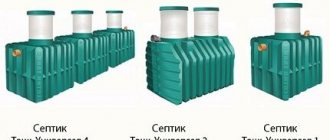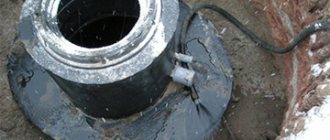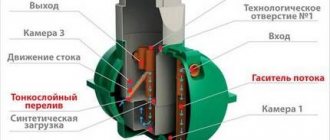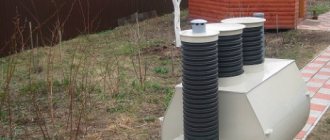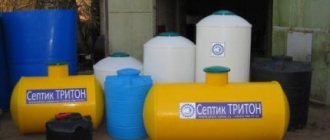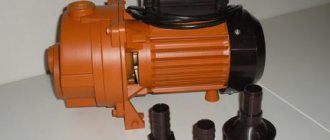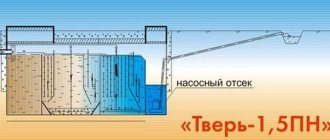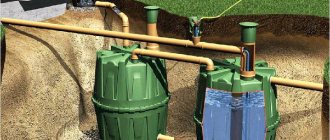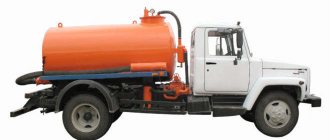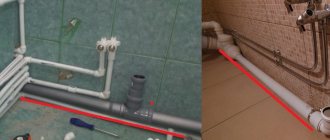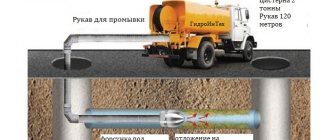A convenient, small-sized solution for a summer house or not fully equipped premises would be a dry closet in a house without a sewer system. It is effective and simple, does not require complex maintenance. There are many design options and models, differing in price and method of waste disposal.
The popularity of dry toilets is constantly growing, despite the limited functionality of the device. It will not replace conventional sewerage, limiting itself to the treatment of physiological waste. To drain drains from showers, washing machines and other plumbing fixtures, you will have to build a separate system. However, a dry toilet allows you to effectively solve the most pressing and urgent problem. This makes it a popular and convenient device.
What it is
Let's look at what a dry closet looks like for a house without a sewer system. Externally, this is a compact set that includes a toilet bowl, a container on which it is installed and a unit that performs the function of a flush cistern. Most models work autonomously, but there are universal or combined designs. A special feature of the device is biological or chemical waste disposal. In addition, there was a complete absence of the bad smell characteristic of ordinary cesspools.
A dry toilet does not solve the problem of drainage from plumbing. It is intended for the reception and treatment of physiological waste only. To drain liquids from other devices, you will need a separate, independent line. This is a feature of the dry closet, which must be taken into account when choosing a method of waste disposal.
The design of most devices resembles the usual design of a floor-mounted compact toilet, only instead of connecting to the drainage line, there is a container for collecting and processing waste in the lower part. It deodorizes and utilizes organic matter. This is how all indoor dry toilets are designed and do not require sewerage. There are more complex designs that can simultaneously operate autonomously and connected to the system. As a rule, the choice of a particular device is determined by several criteria:
- expected working conditions;
- amount of waste;
- container cleaning frequency;
- availability of electricity and running water in the house;
- financial capabilities of the user.
As a rule, any indoor dry toilet without sewerage is not fundamentally different from the street stalls familiar to all city residents. It is not equipped only with outer walls, and the device itself functions in the same way. It will not be able to become a full-fledged alternative to the central sewer system, but it effectively solves the problem of waste disposal.
Features of operating toilets without sewerage in winter
In winter, toilets that are not connected to the central sewer system can be used.
Dry toilets, which process waste using chemicals, are quite functional in cold weather. The only condition is that you need to add antifreeze liquid to the tank. The best choice would be to use propylene glycol. This drug has its own color and the smell is quite pleasant. The main thing is to carefully study the instructions so as not to confuse the proportions. Otherwise, the action of the enzymes responsible for processing waste can be weakened.
If you plan to preserve the system for the winter, then all gaskets need to be lubricated with oil. Better than olive. This will protect the rubber from drying out during frosts.
Subscribe to our Social networks
When do you need a dry closet?
Construction of a full-fledged sewer system in a country house or in a private house is not always possible. When drawing up a system design, you have to maintain certain distances to buildings, wells or boreholes, and other objects. Often, the configuration of the site, the proximity of neighboring buildings, and other factors prevent the fulfillment of all requirements. Some owners deliberately violate the requirements, seeing no other way out. This is fraught with quarrels with neighbors and unpleasant conversations with regulatory authorities. A dry toilet without sewerage, which is not connected to communications and can be located at any convenient point on the site, helps solve the problem.
The best option for using the device is considered to be a summer cottage without permanent residence. If there is no drainage system, electricity or water supply is not connected, you will have to use either an antediluvian toilet or buy a dry toilet.
Many apartment owners use the device during renovations. Sometimes the work drags on for a long time, and the drainage system (or water supply) is turned off, and it is not known when it will be started. Installing a compact device allows you to provide a temporary solution to the problem, and after repair, the device can be transported to your dacha or country house.
Criteria for choosing a toilet
The main criteria for choosing a toilet are as follows:
- Bottom tank capacity . The larger the tank volume, the longer the device operates. A fourteen-liter tank is enough for thirty visits.
- Tank weight . The container sometimes needs to be cleaned. A filled tank with a volume of fourteen liters weighs fifteen kilograms. In the case of a peat system, slightly more. So is it worth purchasing devices with a large volume? Will it be easy to take out such a tank and carry it?
- Toilet height . Keep in mind that you are not the only one using the toilet. There are also children.
- Quality of material . The higher quality the plastic, the longer the product will last.
Advantages and disadvantages
A dry toilet in a house without a sewer system shows serious advantages:
- there is no need to build any additional structures, carry out excavation work, or spoil a landscaped area with green spaces;
- choosing a location for installation does not require taking into account any requirements. If necessary, the device can be freely moved to another point;
- efficiency, simplicity of design;
- no bad smell;
- modern design of devices;
- a large number of design options;
- ease of maintenance, ease of cleaning the device.
There are also disadvantages:
- the price of the device is quite high;
- connection to the ventilation pipe is required;
- drainage is needed;
- Many models require power supply.
Despite the existing disadvantages, dry toilets are in demand due to their compactness and high efficiency. In addition, the cost of constructing a stationary sewer system exceeds the price of compact models, which increases the demand for dry toilets.
Also read: Is it possible to clean the sewer with electrolyte: how to use it, can it be rinsed?
Local treatment plants (VOC or AC)
During normal operation, autonomous sewerage installations are capable of producing fairly clean water. It cannot be used as drinking water or for watering the garden, but as a technical one it is very possible. The basis of cleansing is the work of aerobic bacteria (they live in the presence of oxygen). The waste they process turns into sludge, settles to the bottom of a special tank, from where it is then pumped out. Pumping frequency is 1-4 times a year, depending on the intensity of use.
In general, an autonomous wastewater treatment plant is a good thing, but it has certain operational features that you must know before deciding what is better for the sewage system of a private house - a septic tank or an AC.
This is roughly what installations for an autonomous sewer system in a private house look like. This is AU Topas
At the outlet, the ACs have water purified by 90-95%. With this quality, it can be poured onto the ground, however, for this you must have laboratory tests on hand. Therefore, many still prefer to use an intermediate settling well from which the water is then used for technical purposes. The second option is to divert the wastewater to filter devices. This, of course, is reinsurance, but in emergency situations it saves.
What is used to clean wastewater?
Waste is processed by anaerobic bacteria (they live only in the presence of air). To provide them with air in the VOC, aerators are constantly running. In addition, during cleaning, the contents are pumped from one compartment to another using built-in pumps. So without electricity, these installations are inoperable.
Inside the AU is also divided into chambers (this is Topas)
If the electricity is turned off, bacteria can survive without air for no more than 4 hours, after which they die, and the wastewater ceases to be processed. To start the system, it needs to be populated with new bacteria, and reaching a working state is possible only after 2-3 weeks. All this time, the wastewater will flow, at best, semi-purified. This is where a sump well or filter unit comes in handy. It will improve the situation at least a little.
Features of operation
Since the volume of autonomous treatment plants is small, they need constant feeding: bacteria need nutrients for normal life. Therefore, this type of device is suitable for private homes of permanent residence - regular receipts are needed. In principle, preservation for a certain period is possible, but the procedure is not pleasant, and it will take a long time to return to the installation mode.
Bacteria that process waste in automatic wastewater treatment plants are also sensitive to active chemicals. Since the chamber volumes are smaller, the release of detergents or disinfectants can significantly damage the recycling process. Moreover, cleaning and antibiotic treatment can negatively affect.
Station after operation 3-6 months
VOCs are much smaller in size than septic tanks. They are calculated depending on daily water consumption, but there is such an indicator as salvo discharge. This is the amount of waste that an autonomous sewer installation can accept at one time. If this value is exceeded, untreated wastewater flows into other chambers, which significantly reduces the degree of purification. So, in this situation, you have to decide which plumbing fixtures and household appliances work at the same time. And if the bathtub is drained, no other devices should work for some time.
Briefly: advantages and disadvantages
Autonomous sewerage treatment plants are certainly convenient; with them, sewerage for a private home is implemented quickly - installation takes 10-12 hours. Pumping out excess sludge is necessary several times a year (1-4 times depending on the intensity of use, but maybe less or more often). The amount of sludge pumped out is very small (5-10 buckets depending on the model) and maintenance can be carried out independently, although the procedure is not the most pleasant. But they are doing this, since the visit of a specialist is not cheap at all.
This is what it looks like on the site
These home treatment plants have some disadvantages: the high cost of the equipment, dependence on the availability of electricity and the need to monitor the condition of the equipment.
Varieties
A dry toilet in a house without a sewer system is chosen based on its operating conditions. They are usually divided into portable and stationary. The first ones are compact, light in weight and can be used in small spaces. The latter need to be connected to ventilation and drainage, and power supply.
Different designs are equipped with their own types of fillers. There are different types of devices on sale:
- electrical;
- liquid or chemical (including portable or cassette);
- peat.
Peat models are simpler and more economical. To dispose of waste, they use peat with special microflora. Regular peat will not work, as it does not have the necessary bacteria.
Chemical devices quickly and almost completely process organic matter. Several types of active reagents are used (ammonium, formaldehyde or biological), which are selected based on the point of waste discharge. Biological ones can be poured into a compost pit, the rest require isolated discharge points.
Electrical appliances appeared relatively recently. They are equipped with compressors, a drainage system and other components. For the operation of such structures, a connection to communications is required, so they must be classified as stationary devices.
The main causes of unpleasant odors in the bathroom and toilet
Unpleasant odors do not appear out of nowhere; they always have a source and a reason. Among them are:
- disruption of the technological process during installation work (laying a drain);
- poor ventilation in the room;
- the appearance of invisible cracks and leaks in the sewer drain;
- clogged drain pipe;
- malfunction of the water seal, which is responsible for preventing sewer fumes from entering the premises.
What to pay attention to
When buying a dry closet for an apartment without a sewer system, you must first consider its functionality. Required options:
- flush unit. The most effective models are those with double-sided flushing, where the entire area of the bowl is completely washed;
- pressure valve. Eliminates water splashing;
- storage tank loading indicator, notifying about cleaning time;
- storage volume. The more people use the dry closet, the larger the tank is needed;
- dimensions. It is necessary to think in advance whether it will have to be transported in a car, or installed in a cramped room;
- connection to the sewerage system in the house.
A controversial type of design has become a dry closet with a sewer connection. If it exists, it is easier to build a normal bathroom and not use intermediate devices. However, many owners use this method to reduce the volume of wastewater in a septic tank or cesspool. This allows you to increase the interval between pumping out the tank.
Poor ventilation
Poor ventilation contributes to air stagnation in the toilet or bathroom, as a result of which they are filled with fumes from the sewer, which is not pleasant for residents. Natural draft hoods are often used in hygiene rooms, but they are ineffective because they regularly become clogged with debris.
Experts recommend installing forced ventilation devices operating from a 220V network. They quickly remove not only unpleasant odors from the room, but also moisture after taking water procedures.
To check the natural hood for functionality, you can use a candle or a piece of paper. If ventilation occurs at the proper level, the sheet will stick to the grate, and the flame from the candle will deviate towards it.
Construction from scratch - restroom design
In this case, everything is simple, since toilets are provided for in the project and can be placed on each floor of the future house. It is advisable to provide their location in such a way that they have a single sewer riser, which will save time and material resources spent on construction. Everything will depend on the specific project and the layout of the house. It is advisable that toilets and bathrooms do not have common walls with living rooms. Ideally, these could be external walls, partitions with corridors or technical rooms. Also, toilets and bathrooms should not be located above living rooms.
